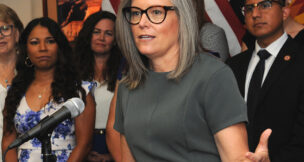Recent Articles from Jim Turner
Irene Vickrey, Arizona’s Unsung Archaeologist
Though incredibly important to Arizona archaeology in her day, Irene Singleton Vickrey’s productive but brief career is known only to a handful of historians and archaeologists.
The ‘dry heat’ arrives in Arizona
In his 1878 book “Picturesque Arizona,” Enoch Conklin quotes Dr. A. M. Loryea: “The heat in Arizona, though high, is endurable in consequence of the dryness.” His statement may be the precursor to Arizona’s most quoted weather phrase: “but it’s a dry heat, so you don’t mind it.”
Oliver Comstock, Unsung Arizona Hero
Sporting a pith helmet, linen suit and big white mutton chop sideburns, Oliver E. Comstock pedaled his bicycle along Tucson’s dusty roads with a soup kettle hanging from the handlebars. He will never be as famous as Wyatt Earp, but he was a real hero to Tent City residents.
Heinrich Balduin Möllhausen: German writer, Arizona’s unlikely explorer
Long before movie cowboys like John Wayne, Gary Cooper and Randolph Scott arrived on the scene, Arizona hosted a different brand of frontiersman. One unlikely adventurer, Heinrich Balduin Möllhausen, was among the first to sketch the Grand Canyon, paint watercolors of the Cocopah, Mojave and Navajo Indian tribes, and recount his observations for a world audience. Möllhausen’s biographer, Prest[...]
The ‘Ancient and Honorable Pueblo’
The Big Apple. The Windy City. The Old Pueblo. Each name says that city is one of a kind. Ever wonder how Tucson came to be called the Old Pueblo? It’s hard to tell how nicknames get started, but like the town itself, it goes back a ways.
The Pyramid of Hi Jolly
Hi Jolly’s pyramid may not be the only pyramid in Arizona, but its composition of quartz and petrified wood along with its unusual metal silhouette of a camel perched on top makes it one of the state’s most notable monuments. Thousands travel past it every day but few realize it’s there.
Why Father Kino?
You can still see his name everywhere, on hospitals, parkways, schools, swimming pools, and even a sports complex. So the question on every newcomer’s mind in Arizona is, why Kino?
Blazing the General Crook Trail
Today, we travel across this diverse landscape on paved roads, in air-conditioned comfort and with radios blaring, unaware of the early pioneers who braved Arizona’s roughest land to lay trails. In remote and untouched areas of Arizona, the old trails remain, where the history of the pioneers’ experiences are remembered.
Tent City Hero
Sporting a pitch helmet, linen suit and big white mutton-chop sideburns, Oliver E. Comstock pedaled his bicycle along Tucson’s dusty roads with a soup kettle hanging from the handlebars. He will never be as famous as Wyatt Earp, but he was a real hero to the residents of southern Arizona’s Tent City.
The Oasis at a Cultural Crossroads
For almost two centuries, Spanish missionaries, mountain men, ’49ers, Civil War soldiers and American settlers benefitted from — and often depended on — the plentiful crops and hospitality of the Pima and Maricopa people.
Global Influence
“It says here Aunt Susie died,” said George Smalley, reading a letter from home at the family dinner table. “Oh, who shot her?” asked his daughter Yndia. It seemed like everyone died that way in Globe in those days.
Times Past: The ‘Mother of Arizona’
Gov. George W. P. Hunt called Josephine Brawley Hughes “the Mother of Arizona.” She fought for women’s suffrage and prohibition of drinking and gambling. She even fought to ban smoking in public. In Arizona’s rowdy territorial days she was often laughed at, but she prevailed courageously.








